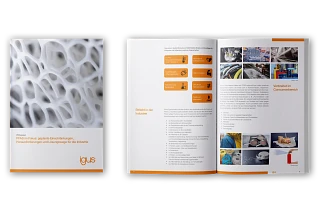Change Language :
igus products and PFAS
As a manufacturer of high-performance polymers, we use a wide variety of materials. Some materials, for example, contain polytetrafluoroethylene (PTFE), which is associated with fluoropolymers and then again with perfluorinated and polyfluorinated alkyl substances (PFAS). Since the EU might ban PFAS in future, you can find some information and background details on these substances and our products below.

The most important facts in brief
- Many of our materials do not contain PTFE.
- According to the OECD, materials with PTFE are "products of low concern" (non-toxic and non-bioaccumulative). No traces of more than 100 of the most critical PFAS compounds could be detected in these materials.
- If PTFE is not banned, our materials are generally not affected.
Background: What are PFAS?
Per- and polyfluoroalkyl substances (PFAS) are industrial chemicals that are used in numerous industrial processes and consumer products due to their special technical specifications.They can be gaseous, liquid or solid and mostly consist of carbon and fluorine atoms.Apart from this, the structures of PFAS molecules can be completely different, which means that they can have many different specifications.
As a group of substances, PFAS include many different compounds: according to the OECD database, more than 4,700, according to the EPA, more than 9,000 and according to the EU Commission, even more than 10,000.From this, you can see that it is neither a unique nor a constant value.The stated value is usually based on estimates.The following diagram provides an overview of the classification of PFAS, first of all into non-polymers and polymers:

Non-polymers
In the subgroup of non-polymers, the compounds perfluorooctanoic acid (PFOA) and perfluorooctane sulfonic acid (PFOS) have been studied the most.Like many PFAS, these two compounds are persistent and can now be found in the environment, the food chain and in people.PFOA and PFOS have a proven negative impact on health.Together with PFHxs and PFNA, they account for 90% of the current contamination with PFAS.
Polymers
In the subgroup of polymers, a distinction is made between fluoropolymers and polymers with fluorinated side chains:
- Fluoropolymers consist of a carbon chain with directly attached fluorine atoms. This makes them so stable that they cannot decompose into toxic substances. According to the OECD, fluoropolymers are "products of low concern", non-toxic and non-bioaccumulative, i.e. they cannot accumulate in organisms. The only risk is the possible use of toxic additives during production in the form of emulsifiers. Fluoropolymers are used, for example, in coatings, seals and cable insulation. Fluoropolymers include PTFE, among others.
- Polymers with fluorinated side chains also consist of a carbon chain, but with side carbon chains to which the fluorine atoms are attached first. As a result, these polymers are less stable and there is a risk of losing the side chains. They are used, for example, as impregnating agents.
Current legal situation regarding PFAS (as of 20.04.2023)
EU: The use of PFOS has been largely banned since 2006 and that of PFOA since July 2020 - you can find our confirmation here. Five European countries (Germany, Netherlands, Denmark, Sweden, Norway) have submitted a proposal for the general restriction of PFAS, which was published by the ECHA (European Chemicals Agency) on 7 February 2023. This proposal is a first step in a long regulatory process and will be reviewed by all stakeholders. The first phase of consultation by all stakeholders will run from 22 March 2023 to 22 September 2023. The proposed PFAS regulation would probably come into force in EU member states in 2026 at the earliest. Possible transition periods of up to 13 years are possible from the date of entry into force.
USA: The EPA has issued a final rule adding five PFAS substances to the list of over 170 PFAS substances. These are reportable under the Toxics Release Inventory (TRI), a centralised database for public reporting of chemicals. Fluoropolymers are not included in the TRI list.
What does a possible PFAS ban mean for igus products?
Regardless of a possible PFAS ban, we already have many materials in our portfolio that do not contain PTFE according to the formulation (download list as PDF):
- iglidur A160, A200, A230, A500, B160, B180, C, F, GLW, i230, J3, M250, R, T220, W160, X6
- igumid G, GLW, NB, TE
Our development department has been working on substitutes for materials containing PTFE for some time now. However, these materials do not necessarily contain critical PFAS compounds. To confirm this, some materials have already been tested for around 100 of the most critical PFAS compounds. The content of the following is below the limit of quantification (as of 15/03/2024):
- iglidur A160, A181, A230, A350, A500, AX500, E7, F, F2, F300, G, G1, GLW, H1, H2, H370, H4, i3, i6, J, J200, J3, J350, K230, L100, L250, M250, P, P210, Q2, Q290, W300, X, Z
- igumid CG, ESD, G, GLW, NB
- igutex TX1, TX2, TX3
- RN312
Note: The presence of ubiquitous traces of undesirable substances can never be ruled out. Since igus has no control over the use of products containing the above materials, we assume no guarantee or liability, express or implied, in connection with the use of this information.
Further information on our products and PFAS

PFAS in focus: planned restrictions, challenges and solutions for the industry
What exactly are PFAS, why are they so popular in industry and the consumer sector? Why is there a threat of an EU-wide ban and what can companies do now? The white paper sheds light on these questions and shows how igus, as a plastics processor, is responding to the planned restriction at an early stage and can offer its customers PTFE-free and PFAS-tested alternatives.